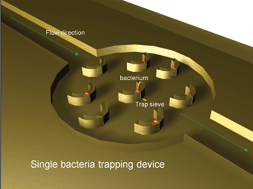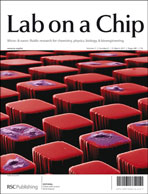Programmed trapping of individual bacteria using micrometre-size sieves†
Abstract
Monitoring the real-time behavior of spatial arrays of single living bacteria cells is only achieved with much experimental difficulty due to the small size and mobility of the cells. To address this problem, we have designed and constructed a simple microfluidic device capable of trapping single bacteria cells in spatially well-defined locations without the use of chemical surface treatments. The device exploits hydrodynamics to slow down and trap cells flowing near a narrow aperture. We have modeled this system numerically by approximating the motion of Escherichia colicells as rigid 3-D ellipsoids. The numerical predictions for the speed and efficiency of trapping were tested by fabricating the devices and imaging GFP expressing E. coli at a high spatio-temporal resolution. We find that our numerical simulations agree well with the actual cell flow for varying trap geometries. The trapped cells are optically accessible, and combined with our ability to predict their spatial location we demonstrate the ease of this method for monitoring multiple single cells over a time course. The simplicity of the design, inexpensive materials and straightforward fabrication make it an accessible tool for any systems biology laboratory.


 Please wait while we load your content...
Please wait while we load your content...